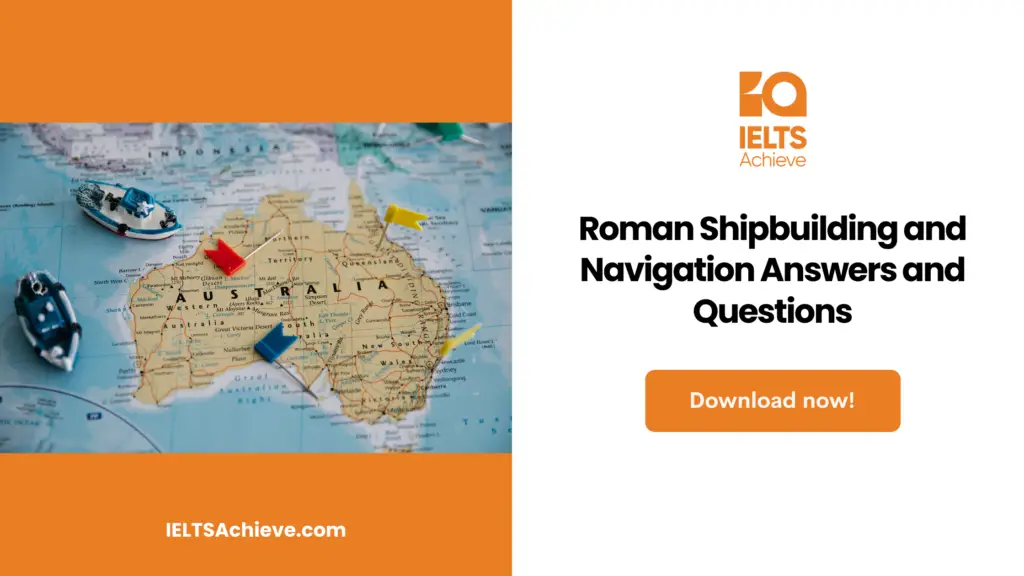The Blog post contains the following IELTS Reading Questions:
- IELTS Reading True, False, Not Given
- IELTS Reading Multiple Choice Questions
- IELTS Reading Summary Completion
Stay informed and prepared for success – Explore our comprehensive Reading Test Info page to get valuable insights, exam format details, and expert tips for mastering the IELTS Reading section.
IELTS reading passage – Roman Shipbuilding and Navigation

Roman Shipbuilding and Navigation
Ships built in modern shipyards adhere to scientific principles and are crafted with the assistance of computers and other cutting-edge gear. Shipbuilding in ancient Rome, on the other hand, was more of an art than a science; it relied on hunches, on tradition, and on the individual’s competence. In spite of the fact that they are commonly thought of as sailors, the Romans were in fact landlubbers who learned the art of shipbuilding from the Greeks and Egyptians that they conquered.
Several historical documents have been preserved that provide descriptions and illustrations of ancient Roman ships, even down to the sails and rigging. Furthermore, ancient shipbuilding knowledge may be inferred from unearthed boats. According to this research, the outer hull was built first by ancient Roman shipbuilders, and then the frame and the remainder of the ship. The outside hull boards were first stitched together. The mortise and tenon jointing method was developed in the sixth century BCE to eliminate the necessity for stitching between the boards. Shipbuilders in the Mediterranean shifted to a method that is being used today in the early centuries of the current era, which entails creating the frame of the ship before the hull and other components. Ship construction times were drastically cut because of this more systematic approach. The ancient Roman fleet and warships were the largest and most technologically advanced in the world up until the early 16th century CE.
Warship design objectives included making them swift and lightweight. They were built with a long, thin hull and little ballast to handle the shallow seas around the shore. After naval battles, it was usual to see them floating on the water’s surface, damaged but still afloat since they wouldn’t sink with the tide after suffering damage. Their bronze battering ram was used to pierce the wooden hulls of other ships and break their oars. Warships were made extremely speedy by the combination of sails and oarsmen. The Mediterranean Sea was given the Latin moniker Mare Nostrum, which means “our sea,” after the Romans eventually gained control of the area. Their navy grew to be the largest and most powerful in the region. There were many different types of battleships. Triremes were the most typical kind of warship from the seventh century B.C.E. to the fourth century B.C.E. Over three levels, there were around fifty rowers on each side. Since they were directly beneath the other rowers and had to contend with water seeping in through the oar holes, the bottom rowers suffered the most. Contrary to popular opinion, the majority of rowers were free Roman citizens who had served in the military, which is crucial to highlight. The trireme was later supplanted by bigger ships with more rowers.
Commercial ships are built to transport heavy loads over long distances for an affordable price. They had a larger hull, double planking, and a sturdy interior for greater stability. They couldn’t reach the coast since their V-shaped hull was deeper than battleships’. A small tiller bar that was connected to a network of cables was used to steer the two large side rudders that were generally found off the stern of these boats. They were equipped with one to three masts, huge square sails, and a small triangular sail in the bow. Commercial ships had oarsmen, just like battleships, but it was hard to manage the hundreds of rowers on both kinds of ships. The oars would keep time with the music as it was performed on an instrument to assist them.
Commercial ships transported a variety of goods, including agricultural products and raw materials such as grain from Egypt’s Nile Valley. Some examples of the raw materials that were transported were iron bars, copper, marble, and granite. In ancient times, Rome was considered to be a major city due to its population of around one million people while it was ruled by the Empire. Both the enormous port of Ostia, which is found at the mouth of the Tiber River and the port of Pozzuoli, which is found to the west of Naples Bay in Italy, would carry products from all over the world to the city. Pozzuoli was located in Italy. The same as it is now, when large commercial ships got close to the port of destination, a number of towboats would meet them and bring them to the dock.
The predicted trip times for the various sailing routes vary greatly. Ancient Roman navigators depended on instinct, acquaintance with the terrain, and careful observation of natural phenomena rather than compasses or other precision instruments. When weather conditions permitted, seafarers in the Mediterranean frequently had land or islands in sight, which greatly benefited navigation. They kept note of where they were with respect to various landmarks to help them navigate. When the weather was rough or land was no longer visible, Roman sailors would utilize the pole star or, less precisely, the Sun at midday to help them find their way. They guessed correctly about the prevailing winds and seas. Large ships traversed the oceans on a regular basis to bring commodities from the Roman Empire, just as contemporary shipping does today.
Unlock your full potential in the IELTS Reading section – Visit our IELTS Reading Practice Question Answer page now!
Recommended Questions:
Renewable Energy IELTS Reading Question with Answer
Roman Shipbuilding and Navigation IELTS Reading Questions
Questions 1 – 3
Do the following statements agree with the information given in the Reading Passage? In boxes 1-3 on your answer sheet, write
TRUE if the statement agrees with the information
FALSE if the statement contradicts the information
NOT GIVEN if there is no information on this
- The Greeks and Egyptians inherited the Romans’ shipbuilding expertise.
- Planks were fastened using the mortise and tenon process, which required skilled craftsmen.
- As they controlled its use, the Romans named the Mediterranean Sea Mare Nostrum.
Enhance your skills in identifying information as True, False, or Not Given. Click here to discover expert strategies and techniques for mastering this question type in the IELTS Reading section.
Questions 4 – 5
Choose the correct letter, A, B, C or D. Write your answers in boxes 4-5 on your answer sheet.
4. Due to which factor, the construction times had to be cut drastically?
- a standardized approach
- technology glitch
- enlightenment of directions
- knowledge from scholars
5. The ships were unable to make it to the coasts because….
- The terrain interrupted
- Coasts were too rough
- The hull mismatched the depth of the ships
- Information was not fully true
Ready to improve your performance in Multiple Choice Questions (MCQs)? Click here to access our comprehensive guide on how to tackle MCQs effectively in the IELTS Reading section.
Questions 6 – 13
Complete the summary below.
Choose ONE WORD ONLY from the passage for each answer. Write your answers in boxes 6-13 on your answer sheet.
Warships and merchant ships
It was important that warships be both 6. ______ and fast in order to be effective. They could avoid sinking during engagements and sail near shore since they were light. The plan called for a 7. ______ battering ram to smash the wooden hulls and break the oars of the enemy ships. The ‘Trireme,’ a type of warship, had rowers stationed on three 8. ______.A commerce ship’s broad 9. ______ would often extend well below the water’s surface, in contrast to the narrow hulls of warships. Large rudders and a tiller bar were used to guide merchant ships through the sea. There were squares and 10. ______ sails on board. It was common practice for rowers on both commercial and military vessels to employ 11. ______ to synchronize their strokes. Merchant ships carried a large quantity of 12. ______ and other agricultural products to two major ports in Italy. 13. ______ assisted in bringing the vessels ashore. When the skies were clear, sailors would utilize familiar land or island features to guide them to safety.
Boost your performance in Summary, Notes, Table, and Flowchart Completion tasks. Click here to explore our detailed guide and learn how to effectively complete summaries, notes, tables, and flowcharts in the IELTS Reading section.
Unlock your full potential in the IELTS Reading section – Visit our IELTS Reading Practice Question Answer page now!
Recommended Questions:
Renewable Energy IELTS Reading Question with Answer
Roman Shipbuilding and Navigation Reading Answers
1. Answer: False
2. Answer: Not Given
3. Answer: True
4. Answer: A
5. Answer: C
6. Answer: Lightweight
7. Answer: Bronze
8. Answer: Levels
9. Answer: Hull
10. Answer: Triangular
11. Answer: Music
12. Answer: Grain
13. Answer: Towboats

We hope you found this post useful in helping you to study for the IELTS Test. If you have any questions please let us know in the comments below or on the Facebook page.
The best way to keep up to date with posts like this is to like us on Facebook, then follow us on Instagram and Pinterest. If you need help preparing for the IELTS Test, join the IELTS Achieve Academy and see how we can assist you to achieve your desired band score. We offer an essay correction service, mock exams and online courses.

